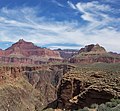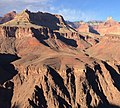| Cheops Pyramid | |
|---|---|
 South aspect, from South Rim's Yavapai Point | |
| Highest point | |
| Elevation | 5,401 ft (1,646 m) [1] |
| Prominence | 800 ft (240 m) [1] |
| Parent peak | Isis Temple (7,006 ft) [2] |
| Isolation | 1.72 mi (2.77 km) [2] |
| Coordinates | 36°07′13″N112°07′12″W / 36.1203033°N 112.1201072°W [3] |
| Geography | |
| Country | United States |
| State | Arizona |
| County | Coconino |
| Protected area | Grand Canyon National Park |
| Parent range | Kaibab Plateau [1] Colorado Plateau |
| Topo map | USGS Phantom Ranch |
| Geology | |
| Rock type(s) | sandstone, limestone, shale |
| Climbing | |
| Easiest route | class 4 climbing [2] |
Cheops Pyramid is a 5,401-foot-elevation (1,646-meter) summit located in the Grand Canyon, in Coconino County of Arizona, US. [3]









